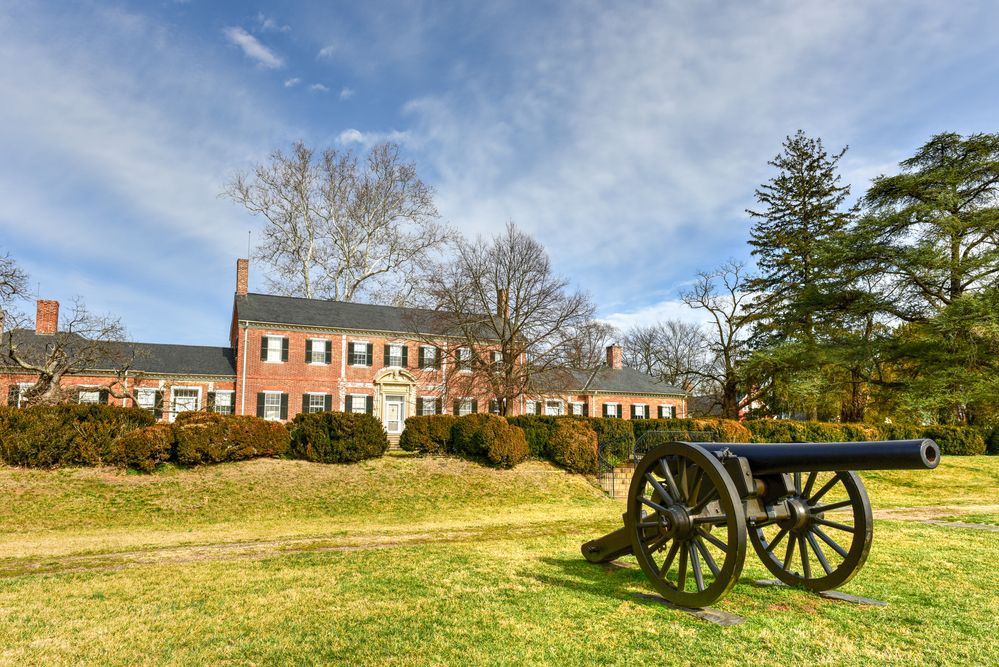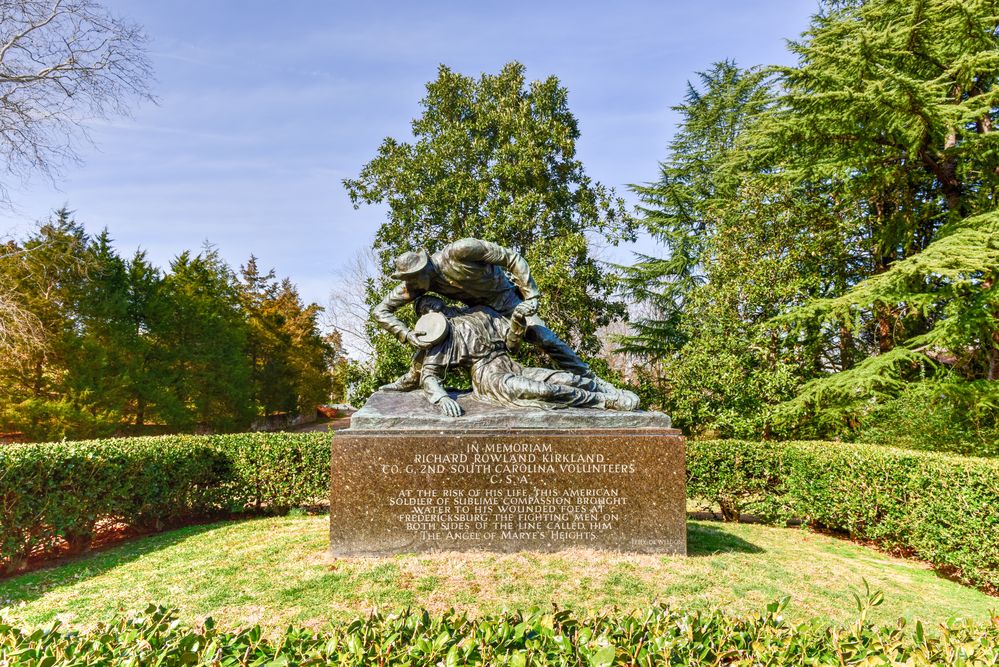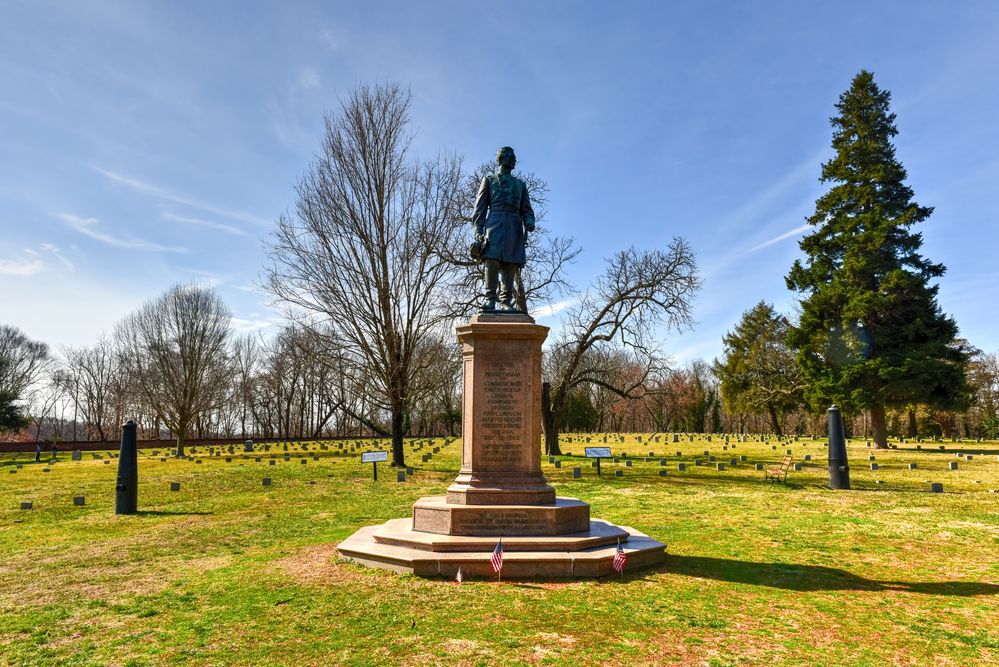This National Military Park commemorates four major battles in the American Civil War in Fredericksburg, VA and Spotsylvania County. The battles were Fredericksburg, Chancellorsville, The Wilderness and Spotsylvania. The National Park Service refers to it as “America’s Battleground” where more 15,000 were killed and more than 85,000 wounded. The outbuilding where Stonewall Jackson died after being shot accidentally by Confederate troops at the Battle of Chancellorsville is also located here in the park.



Fredericksburg and Spotsylvania National Military Park is located in Fredericksburg, Virginia, and extends into Spotsylvania County. Fredericksburg, Virginia, is an independent city located in the Commonwealth of Virginia. It is situated 49 miles (79 km) south of Washington, D.C., and 58 miles (93 km) north of Richmond. The city is positioned near where the Rappahannock River crosses the Fall Line, and it was a prominent port during the colonial era.
What happened at the battle of Fredericksburg?
The Battle of Fredericksburg took place from December 11-15, 1862, in and around Fredericksburg, Virginia. Here’s a summary of what happened:
Union Forces: The Union Army of the Potomac, commanded by Major General Ambrose Burnside, aimed to cross the Rappahannock River and advance on the Confederate capital of Richmond.
Confederate Forces: The Confederate Army of Northern Virginia, led by General Robert E. Lee, occupied strong defensive positions on the heights behind Fredericksburg, including Marye’s Heights.
Crossing the River: Union forces faced delays in receiving pontoon bridges to cross the river, giving Lee time to fortify his positions. When the Union finally crossed under fire on December 11-12, they were met with strong Confederate defenses2.
Futile Attacks: On December 13, the Union launched multiple frontal assaults against the entrenched Confederate positions. The attacks were repulsed with heavy casualties, particularly at Marye’s Heights, where Confederate artillery and rifle fire inflicted severe losses on the Union troops2.
Outcome: The Union forces were unable to break through the Confederate lines and suffered over 12,000 casualties, while the Confederates incurred about 5,000 casualties. The battle was a significant Confederate victory and a major defeat for the Union2.
Aftermath: The defeat at Fredericksburg led to criticism of General Burnside’s leadership and contributed to his eventual replacement. The battle also bolstered Confederate morale and delayed Union plans to advance into Virginia.
The Battle of Fredericksburg is remembered as one of the most one-sided battles of the Civil War, with Union casualties more than twice as heavy as those suffered by the Confederates.
What happened at the battle of Chancellorsville?
The Battle of Chancellorsville, fought from April 30 to May 6, 1863, in Spotsylvania County, Virginia, is often considered General Robert E. Lee’s greatest victory during the American Civil War. Here’s a summary of what happened:
Union Forces: The Union Army of the Potomac, commanded by Major General Joseph Hooker, aimed to defeat Lee’s Army of Northern Virginia and possibly capture the Confederate capital of Richmond.
Confederate Forces: General Robert E. Lee, despite being heavily outnumbered, decided to take a bold and risky approach by dividing his army in the presence of a much larger enemy force.
Initial Movements: Hooker’s plan was to outflank Lee’s army by crossing the Rappahannock River and attacking from the rear. However, Lee anticipated this move and split his forces to meet the Union army head-on2.
May 1-2: The battle began with skirmishes, and on May 2, Lee executed a daring flanking maneuver led by General Thomas “Stonewall” Jackson. Jackson’s forces marched 15 miles to attack the Union right flank, causing chaos and heavy casualties among the Union troops2.
Jackson’s Wounding: During the night of May 2, Jackson was accidentally shot by his own men while scouting ahead, resulting in the amputation of his left arm. He died of pneumonia eight days later, a significant loss for the Confederate army3.
May 3-6: The battle continued with fierce fighting, but the Union forces were unable to break through the Confederate lines. Hooker eventually withdrew his army to a defensive position, and Lee chose not to pursue, allowing the Confederates to claim victory.
Outcome: The Battle of Chancellorsville was a significant Confederate victory, but it came at a high cost, with heavy casualties on both sides. The loss of Stonewall Jackson was a major blow to the Confederate army3.
The battle is remembered for Lee’s audacious tactics and the tragic fate of Stonewall Jackson, making it one of the most studied engagements of the Civil War.
What happened at the battle of The Wilderness?
The Battle of the Wilderness, fought from May 5-7, 1864, was the first battle of General Ulysses S. Grant’s Overland Campaign against General Robert E. Lee’s Army of Northern Virginia. Here’s a summary of what happened:
Location: The battle took place in the dense, wooded area known as the Wilderness of Spotsylvania and Orange Counties, Virginia.
Union Forces: The Union Army of the Potomac, commanded by General George G. Meade with oversight from Grant, aimed to engage Lee’s army and move towards the Confederate capital of Richmond.
Confederate Forces: General Robert E. Lee’s Army of Northern Virginia was well-entrenched and familiar with the terrain, which gave them a defensive advantage.
May 5: The battle began with fierce fighting along the Orange Turnpike and Orange Plank Road. The dense woods made it difficult for both sides to maneuver, resulting in chaotic and brutal combat1.
May 6: Fighting continued with heavy casualties on both sides. The Union forces launched several attacks but were unable to break through the Confederate lines3.
May 7: Grant decided to disengage and move his army southeast, continuing his offensive towards Richmond. Despite the inconclusive nature of the battle, Grant’s decision to keep pressing forward marked a shift in Union strategy2.
Casualties: The battle resulted in approximately 17,666 Union casualties and 11,033 Confederate casualties, making it one of the bloodiest battles of the war.
What happened at the battle of Spotsylvania?
The Battle of Spotsylvania Court House, fought from May 8-21, 1864, was part of General Ulysses S. Grant’s Overland Campaign against General Robert E. Lee’s Army of Northern Virginia. Here’s a summary of what happened:
Location: The battle took place in Spotsylvania County, Virginia, near the village of Spotsylvania Court House.
Union Forces: The Union Army of the Potomac, commanded by General George G. Meade with oversight from Grant, aimed to engage Lee’s army and move towards the Confederate capital of Richmond.
Confederate Forces: General Robert E. Lee’s Army of Northern Virginia occupied strong defensive positions, including a prominent salient known as the “Mule Shoe” or “Bloody Angle”.
May 8-10: Union forces attempted to dislodge the Confederates from Laurel Hill and other positions but were unsuccessful.
May 12: Grant ordered a massive assault on the Mule Shoe, led by Major General Winfield Scott Hancock’s corps. The Union troops initially broke through but were eventually repulsed by the Confederates2.
May 12-13: The fighting at the Bloody Angle involved almost 24 hours of intense, hand-to-hand combat, making it one of the most brutal engagements of the Civil War.
May 21: After repeated attacks failed to break the Confederate line, Grant decided to disengage and continue his march southward.
Outcome: The battle was tactically inconclusive, but both sides claimed victory. The Union declared victory because they continued their offensive, while the Confederates held their defenses2. The battle resulted in approximately 18,000 Union casualties and 12,000 Confederate casualties.
The Battle of Spotsylvania Court House was part of Grant’s relentless pursuit of Lee’s army, ultimately leading to the Union’s strategic victory in the Overland Campaign.
Antietam National Battlefield
Cowpens National Battlefield
Fort Donelson National Battlefield
Fort Necessity National Battlefield
Kennesaw Mountain National Battlefield
Manassas National Battlefield
Monocacy National Battlefield
Petersburg National Battlefield
Richmond National Battlefield
Stones River National Battlefield
National Military Parks
Chickamauga and Chattanooga National Military Park
Fredericksburg and Spotsylvania National Military Park
Gettysburg National Military Park
Kings Mountain National Military Park
Shiloh National Military Park
Vicksburg National Military Park
